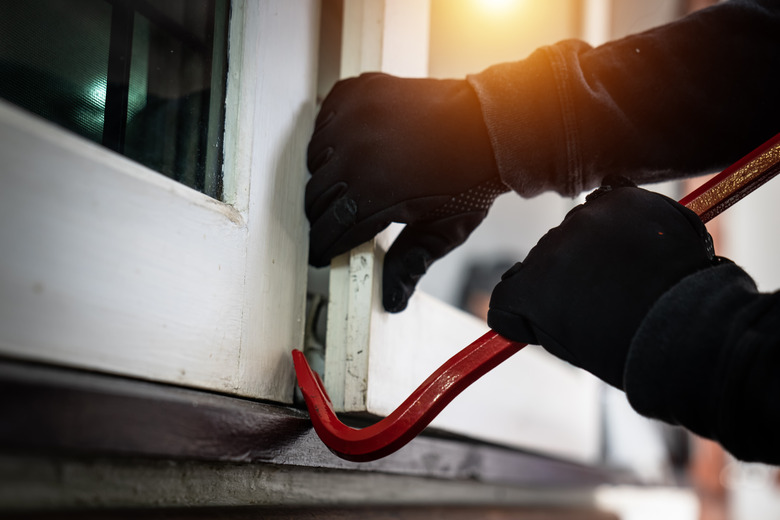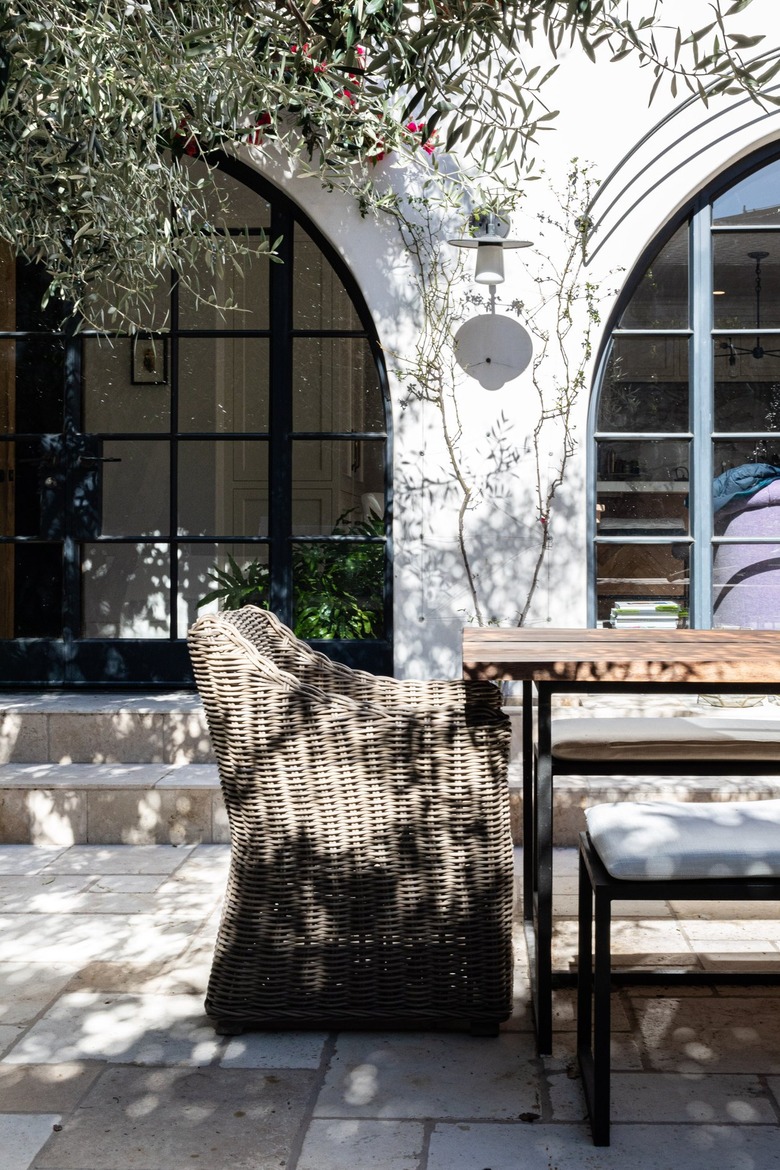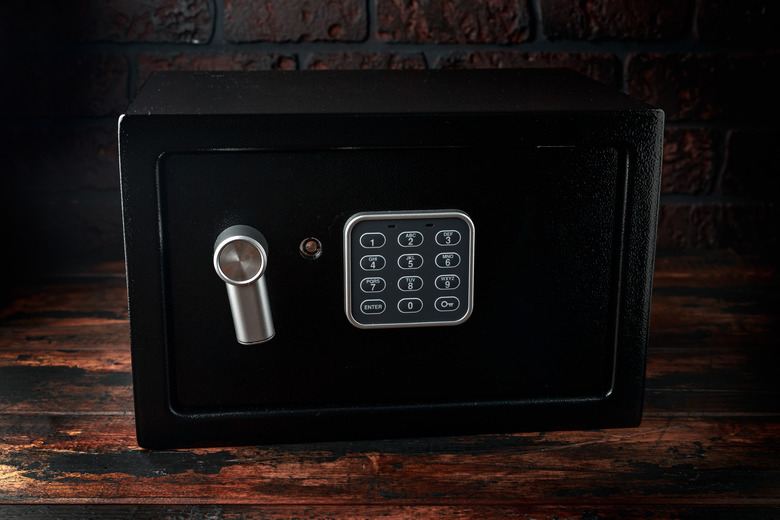15 Easy (And Cheap) Ways To Burglar-Proof Your Home
One glance at crime statistics is probably enough to make you want to burglarproof your home. Some 1.1 million burglaries occurred in the United States in 2019, and about 63 percent of these were home invasions. It's scary to think about becoming the victim of a crime, but you can take steps to make sure that your home is not among the burgled. While a professionally installed, whole-home security system with around-the-clock monitoring will cost a pretty penny, simple hacks, DIY upgrades and habit changes can go a long way toward keeping burglars at bay and giving you peace of mind.
1. Replace Your Doors
1. Replace Your Doors
The most common entry points to your home — for guests and burglars alike — are your doors. Many break-ins start with a well-placed kick to the front or back door. If your exterior doors are hollow-core doors, replace them with solid wood or metal doors. While you are at it, make sure that the hinges are not exposed to the outside since that makes unauthorized entry easier.
2. Add More Door Protection
2. Add More Door Protection
While you are working on the doors, install deadbolts with throws of 1 inch or longer and a solid strike plate (where the bolt enters). The strike plate must be attached to a wall stud, and the screws holding it in place should be at least 3 inches long. If it's just tacked to the door jamb, a hard kick might be enough to bust it open.
For extra security, think about getting door jamb and/or strike plate reinforcement kits. They are available for under $100 and can be very effective. A steel door jamb guard prevents the wood from splitting if the door is kicked in, while steel strike plates fix that deadbolt solidly in place.
3. Reinforce Your Windows
3. Reinforce Your Windows
Some security experts list windows even before doors as a burglar's preferred mode of entry. Window glass never stands up to a brick, crowbar or hammer very well unless it is laminated.
Former burglars addressing home security on social media have listed laminated window glass as the top tip to prevent a burglary. Yes, laminated glass will break eventually but not with the first or second bash, giving the homeowner notice of the attack. Criminals are likely to take off and look for a more vulnerable home if a few hits fail to smash the window.
Consider bars on first-floor windows, which work, though the aesthetic leaves something to be desired. Egress windows (required in sleeping rooms), however, must have egress-type security bars that can be opened from the inside.
4. Brace Sliding Doors/Windows
4. Brace Sliding Doors/Windows
It's cheap, easy to install and uber effective, and people have been doing it for generations: bracing a sliding door or window with a piece of wood. This can be something as simple as a small baseball bat or a piece of broom handle. When placed strategically in the window or door frame, it will prevent that door or window from sliding open.
If you like the notion but hate the look of a wood brace, install a patio door or sliding window lock. These are cheap and easy to install, acting like a deadbolt lock to prevent the sliding action. For doors, look for foot-operated locks so you don't have to squat down every time you want to unlock it.
5. Install Keyless Door Locks
5. Install Keyless Door Locks
Getting your front door bashed in is bad but having a thief open it with your own lost keys might feel even worse. Lots of people lose, misplace or lend out door keys or "hide" them under the front door mat or in a nearby potted plant — places every burglar is likely to look. Experts suggest that you "lose" your keys once and for all and install smart locks instead.
With a smart lock, you get in with a fingerprint scan, a passcode or a mobile phone. With some, you can open the door remotely to allow in a guest or repairperson. Generally, you install smart locks quickly and easily without drilling or hardwiring. Electronic keypad models are the least expensive if budget is on your mind.
6. Lock Your Doors
6. Lock Your Doors
All the burglarproofing devices out there will not help you if you don't use them, so be sure you do. This is totally free to implement but also very important. Those who think they live in a safe neighborhood may not feel the need to use the locks they have if they run out to pick up the kids or take a quick shopping trip. Over a third of residential burglars just walk into homes through unlocked front doors, making them easy targets.
7. Keep the Lights On
7. Keep the Lights On
Don't advertise your absence by turning off the lights whenever you are out. This signals your empty home to burglars looking for a place to "visit." On the other hand, if you take off for a well-deserved 15 days in the sun, it doesn't help much to leave on one light the entire time. Burglars are clever in noticing things like one kitchen light left on for weeks on end. So, use automatic light timers.
It won't cost you very much to buy and install automatic timers for indoor lights. With these, you can turn on some lights and turn off others during the day. Buy the kind you can program with variable on/off times so it actually looks like you are home. Alternatively, get a neighbor to come by and switch your lights on and off or find a housesitter to stay in your place while you are gone.
8. Leave On the Radio or TV
8. Leave On the Radio or TV
Another great way to burglarproof your home is to leave a talk radio or TV channel playing. Don't turn it on full blast or the neighbors may complain. The idea is to offer a murmur of voices in the living room — something that sounds like a normal conversation to anyone trying to figure out if the house is empty. The automatic timers make this ploy more believable over time. Very few people actually have a conversation going or a radio or television turned on 24/7.
9. Install Motion-Sensor Lighting
9. Install Motion-Sensor Lighting
One well-known way to foil burglars is to shine a light on what they are doing — that is, install motion-sensor outdoor lights. Pick a kit with bright lights that turn on automatically when the machine detects motion in its range. These can be mounted anywhere burglars are likely to approach, such as near doorways or in shrubby areas that would otherwise offer them cover. The lights blaze on when a burglar approaches, alerting you and scaring off the thief.
There are a broad range of motion-sensor outdoor light kits on the market. You can get hardwired products but also those that are battery powered or even solar powered. Check out the prices and pick whatever fits your budget.
10. Keep Plans Off Social Media
It may be fun to brag about your upcoming trip to Bora Bora on Facebook or Instagram, but that may bring your absence and its timing to the attention of burglars. Resist even mentioning your departure and then post the dramatic photos of the palm trees against the sunset sky when you get home. Instead of creating pre-vacation posts to make your friends drool, use that time to make sure your Amazon deliveries won't be sitting on the porch while you are gone, and arrange to have the mail held until you return. A good neighbor could do both of these things as well.
11. Fake It 'Til You Make It
11. Fake It 'Til You Make It
Consider it a white lie. If you'd love a home security system with all the security cameras and alarms but aren't ready to pay the price, get a fake "protected by" sign or sticker and display it in your yard. These are not guaranteed to work, of course, but just seeing the sign may make burglars look elsewhere. The threat of surveillance could be enough to scare them off.
Where can you get a fake sign? You can easily find one online for less than $20, and there's no law against it. You can plant a home security sign in the front yard whether you pay for the service or not.
12. Make Your Entrance Visible
12. Make Your Entrance Visible
In addition to motion-sensor lights, make sure the entrance to your home is well-lit. This simple action will ward off many burglars who won't want to risk being seen by neighbors or someone driving by. The best thing to do is to set automatic lights that will illuminate the front entry door at a certain hour every night. That means that the front door light will continue turning on whether you are there or not.
13. Put in Loud Alarms
13. Put in Loud Alarms
Top of the line protection can be obtained from a complete home security and alarm system, but the cost can be prohibitive, and you pay for professional monitoring on a monthly basis. What can you do that's more affordable? How about really loud wireless alarms that you can put on a door or window? Most of these blare when they feel motion, such as if the door or window is opened, but some also go off when they sense vibrations from glass breaking.
If you focus on what these alarms do, they are impressive. At less than $10 a pop, they have a peel-and-stick application that allows you to place them wherever you like. When they sound off, everyone in the house hears the piercing siren. Some operate at 110 decibels! They are easy to turn off when you want to open the door. What they don't do is provide video surveillance or sound an alarm at the police station, but they are certainly loud enough to wake you and scare the burglar.
14. Protect Valuables in a Safe
14. Protect Valuables in a Safe
Even if a burglar should make his way into your home, you can save your valuables by installing a small safe. Most people don't require a huge safe. It depends on how many really precious or expensive items you will put in it. You can likely get a sufficiently large safe for $100 that will keep out burglars. Pay a little more and make it fireproof in case your home burns.
Bolt the safe to the floor in a hidden spot, like in a dark closet corner. Alternatively, position it inside a wall and then cover it with a wall hanging or other decor. Some people prefer to simply stash their jewelry in unlikely places, like empty food cans, but make sure they don't get thrown away. The trick to a safe or a hiding place is making it a habit to put valuables inside when you aren't using them.
15. Don't Throw Your Name Around
15. Don't Throw Your Name Around
In the days of yesteryear, it was a common habit in some areas to put the family name on the front of a home and/or on the mailbox. However, it is good to avoid this action. That's because it gives a criminal easy access to figure out whether you are home or not. With your name and address, a burglar may be able to find your phone number and give the house a call or use the information to fool the neighbors into thinking he's a friend.


